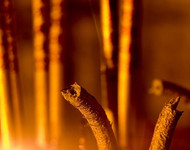How is Incense made & How can I make my own Incense?
Posted by Brett Almond
Incense has been used in various cultures around the world for millennia, and it’s not hard to see why. It can be made in many different ways to create a dizzying variety of alluring and relaxing scents. You might use yours to create a sense of tranquillity, for meditation or other spiritual practices, or simply to make your rooms smell nice.
The word incense comes from the Latin incendere, which means ‘to burn’. Most incense products combine aromatic plant matter with essential oils and resins and are designed to burn at a slow and even pace, producing aromatic smoke as they do so.
What are its origins?
No one knows exactly when people first started making and burning incense. However, there is evidence that the Ancient Egyptians and the Babylonians burned it during their rituals. Its use at ceremonial events was also recorded in China as far back as 2000BC. From there, the custom spread to India where it was used in early Hindu ceremonies.
How do indirect-burning and direct-burning versions compare?
Before we get into exactly how incense is made, it’s important to distinguish between indirect-burning and direct-burning versions. The first group of products are made using a combination of aromatic ingredients that are not prepared in any particular way or encouraged into any particular form. This means they aren’t suitable for direct combustion and instead require a separate heat source. Typically, the heat is provided by charcoal or glowing embers. An exmaple being frankincense resin.
You’re probably more familiar with direct-burning incense, and that’s what this article will focus on. These products also feature aromatic ingredients, but they include binding and combustible materials too. After being formed and dried they can be lit and, once the flame is fanned out, they burn continuously by themselves. This incense usually comes in either stick or cone form.
What are the main ingredients?
The precise ingredients found in incense differs from product to product, but there are certain essentials that remain constant. Historically, the chief components were resins like frankincense and myrrh, aromatic wood and bark and additions such as seeds, roots and flowers.
How does it differ from country to country?
Each major incense producing country has developed its own traditions and here are some of the most prominent:
Indian Incense
In India, incense usually comes in stick form. These products are typically made using a bamboo stick and a paste comprising a range of ingredients, including charcoal dust and binding agents. The paste is used to coat the stick and then it is perfumed with mixtures made using additions such as cloves, ginger and sandalwood. This can be done either by rolling the stick in a spice mix powder or by dipping it into fragranced liquids. In some cases, stick machines are used to complete this process. However, many are still hand rolled.
Chinese Incense
Chinese incense generally comes in stick form too and ingredients commonly used to fragrance it include agarwood, sandalwood, star anise, cinnamon, frankincense and cloves.
Japanese Incense
In Japan, solid stick incense is popular. These products have no supporting core and they’re made entirely from incense material. They can be produced by forcing the incense mixture through a hydraulic press. The resulting sticks are then dried slowly to avoid warping.
A popular ingredient in Japanese incense is tabu. The bark of this tree is often used to form the shape of the products. Benzoin resin from the styracaceae tree is another common addition, along with sandalwood.
Tibetan Incense
Like Japanese incense, Tibetan versions do not have a stick at their core. They have a characteristic earthy scent to them and their ingredients can include the likes of cinnamon, cloves and juniper. They can also be much thicker in diameter than most incense sticks.
How can I make my own sticks or cones?
All incense producers have their own techniques when it comes to creating these fragrant items and the methods vary considerably depending on the traditions involved. However, there are certain basic principles that you can apply if you’re ever tempted to have a go at making your own sticks or cones.
Firstly, you’ll need to take high-quality natural ingredients to create your loose incense. You can choose from a variety of woods, resins, herbs and spices. Here are some examples of each type of ingredient:
● Woods: sandalwood, agarwood, pine, cedar
● Resins: amber, myrrh, frankincense, hibiscus
● Herbs and spices: vanilla, sage, ginger, cinnamon
Try to always use at least one resin or wood in your mixture.
Next, pulverise these ingredients into a very fine powder to aid the burning process. The resulting mixture can be combined with charcoal powder and a binding agent such as tragacanth. To this mix you can add makko powder, which is made from the bark of the tabu-no-ki tree. This is a combustible material that’s also water soluble.
When added to the loose incense mix along with a little distilled water, makko allows for the formation of incense cones or sticks. The water should be added very slowly while you mix the ingredients. You want the mixture to become gummy and pliable yet still hold firm when it is moulded.
Once it’s at the right consistency, you can form the mix into cones or apply it to sticks. If you’re using bamboo sticks, make sure you get blank versions with no additives. Once you’ve made the items, leave them to dry. This can take a couple of weeks or more and bear in mind that cones tend to take longer that sticks. To see if cones are ready, turn them upside down and make sure that their undersides are all one colour. If they are darker in the middle, they need more time.
Next comes the fun part; you get to test your creations! If you find they don’t burn steadily, you might need to increase the amount of makko you add. On the other hand, if they burn too fast, decrease the makko content.
If an incense producer says ‘sandalwood’ is it always sandalwood that is used, or could it be a perfume imitation?
Let’s face it, we don’t all have the time, resources or indeed inclination to make incense from scratch. If you’d rather take the easier option, you can buy the finished items online. However, always make sure you choose high-quality products. After all, not all incense is created equal.
For example, sandalwood is a classic incense ingredient. It’s renowned for its subtle, sweet, rich and warm fragrance, which has made it hugely popular with people across the globe. Indeed, it has proved such a hit around the world that the current production of sandalwood is not enough to meet the high demand among consumers and the resource is dwindling. In particular, East Indian sandalwood is increasingly endangered.
As you might suspect, this has led certain unscrupulous traders to mislead consumers as to the presence of sandalwood essential oils in their products. For example, some sellers claim they are using true, steam distilled essential oils when in fact they are using diluted versions or synthetic perfumes.
When you’re buying incense, it’s important to find reputable vendors and to pay attention to the ingredients. This way you can be sure you know what you’re really getting.
Has much changed over the years?
One of the most distinctive qualities of incense is its enduring appeal. People have been burning the stuff for thousands of years and the experience they have when they do may have changed relatively little over this time. For this reason, lighting an incense stick or cone can feel like stepping back in time.
Surprisingly little has changed about the production methods too. Many incense sticks are still made using traditional paste rolling or powder coating techniques. While these can be performed by machine, they are often done by hand.
However, to reduce labour costs, companies are increasingly turning to the more efficient compression method. This involves mechanically forming a damp powder around a stick.
What about the smoke? Can it do me any harm?
Incense might help you to relax, unwind and perhaps to meditate. This is good news for your health and it can be the perfect antidote to the stresses of daily life. However, you might be concerned about the potential ill-effects associated with inhaling the smoke .
As a general rule, it’s not advisable to breathe in too much smoke of any kind. With this in mind, if you use incense a lot, it’s important to make sure that the rooms you’re in are well ventilated. You can achieve this by simply opening a door or window to improve airflow.
How can I make the most of my incense?
To get the very most from your incense, you might want to follow these top tips. Firstly, find a fragrance you really like. There are so many different versions to choose from and you might not enjoy them all. Don’t be put off if you’re not a fan of the first incense you buy. There are plenty more to try!
It’s also a good idea to invest in a good incense burner. Some of these products are universal and can be used for burning many varieties of incense. However, others only work for specific types. For example, stick burners are typically long trays that turn up at the end, while cone burners usually have metal containers in them to hold the incense.
Before lighting your incense, make sure you place your holder on a flat, non-flammable surface in a well ventilated area. However, try to avoid putting it near windows as this may cause ashes to blow around your room.
© Holisticshop.co.uk. All rights reserved



